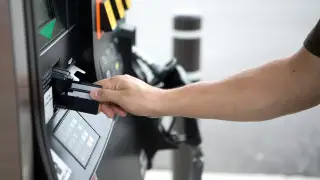Simply swiping a debit card at a card reader can put you at risk of fraud, but you can easily reduce this risk by knowing where not to swipe your card.
Illegally obtaining credit or debit-card information from a card reader is a type of scam called skimming. The scammer uses captured data or records the cardholders’ personal identification number (PIN) to fraudulently create a fake card and steal from the associated account. Skimming costs financial institutions and consumers over $1 billion each year, according to the FBI.
Debit cards, unlike credit cards, aren’t protected by the Fair Credit Billing Act, regulation that limits consumer liability for unauthorized transactions to $50. Instead, debit cards fall under the Electronic Funds Transfer Act. Under this law, consumers could lose up to $500 if they don’t report fraud within two days.
Retail stores
Though it isn’t always avoidable, paying with a debit card at retail stores can make consumers vulnerable to skimmers. An alternative to swiping your debit card is using a contactless payment method. Any information that can be obtained from contactless payment is insufficient to create a fraudulent card, according to Secure Technology Alliance. Most stores offer a tap to pay option on their card readers, which works with many debit cards as well as Apple Pay and Google Pay.
Using a credit card is another safer option to pay. If none of these options are feasible, then using a debit card with chip technology is still safer than swiping it.
Use your smartphone to make payments to help outsmart fraudsters
More brick-and-mortar retailers offer payment options that don’t require a debit card. More than half (56 percent) of retailers accept mobile payments, according to 2020 data from the National Retail Federation. With contactless payment, consumers are avoiding not only germs but also scammers.
It’s smart to leverage digital wallets and other types of digital payments, says Buzzard of Javelin Strategy and Research. “Each time you make a payment using one of these methods, your payment card information is not exchanged with the merchant but rather with a stand-in token that makes up a safer encrypted transaction. You can speedily purchase gas at the pump using these methods as well.”
Though the transactions are safer, it’s important to remember that your mobile wallet is susceptible to theft, too, so it’s important to follow the basics of smartphone safety.
“Enable ‘find my phone or device location’ in case you lose your mobile device,” Buzzard says. Some smartphones can also be wiped clean remotely, if it appears to be in a suspicious location.
Make sure to keep your screen locked. “There are really no excuses for not protecting your payment apps from criminals. Facial scans [and] fingerprint protections known as biometrics work splendidly to protect your information,” Buzzard says.
Additionally, be wary of the potential for cybercrime. Consider installing identity theft-protection software to protect your devices from malware and data breaches.
Malware is usually downloaded via phishing, which can occur when you click on an unknown link from a text or email, says Zirkle of ACFE. Further, he says, “Credit cards in a mobile wallet are always going to be safer than using debit cards due to legal protections.”
Analysis
I own a debit card, but I have never used it. I’ve always just used my credit card to build up my score, plus I’ve always been told to avoid using debit because there’s a big risk of fraud. What this article taught me is that there’s an equal risk of fraud with both credit and debit, but credit cards are more protected. If your credit card gets hacked, consumers are liable for up to $50. If your debit card gets hacked, consumers are liable for up to $500. Big difference! My understanding of this disparity is that with credit, you’re spending the credit card company’s money, so they care a lot more about it than your personal funds. That’s sort of a crude way of saying it, but I think that pretty much covers the point. So it seems that the problem with fraud comes with where your card information goes whenever you spend money. I wonder if there are ways to better protect debit cards from getting hacked in the first place? Or, is there a way to verify that you are the person making your purchases? I’m imagining some sort of fingerprint scanner on a card to quickly verify that you are indeed the person making your purchase. But then there’s the problem of online shopping 😉
Another thing I learned from this article is that contactless payments pretty much reduce the chances of fraud by 100%, because the information transferred in a contactless payment isn’t enough to make a fraudulent card. Your personal information isn’t transferred, but rather a stand-in token that processes later, so your numbers are protected at all times. It seems, then, that the future of buying stuff is completely contactless and much safer.
Source
Bennett, R., & Schepp, D. (2022, May 25). Places to avoid using your debit card. Bankrate. https://www.bankrate.com/banking/checking/risky-places-to-use-debit-card/#if-compromised




